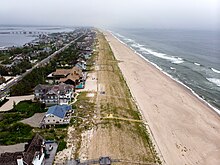Barrier island
**Barrier Island Formation and Characteristics:**
– Constituent parts include upper shoreface, middle shoreface, lower shoreface, foreshore, and backshore.
– Locations of barrier islands on every continent except Antarctica.
– Specific examples in Australia, the United States, Canada, Mexico, New Zealand, and India.
– Processes such as overwash, evolution, migration, and critical width concept.
– Formation theories like offshore bar, spit accretion, and submergence.
– Types of barrier islands: wave-dominated and mixed-energy.
– Boulder Bank in New Zealand as a unique example.
**Barrier Islands Around the World:**
– Barrier islands prominent on the East and Gulf Coasts of the United States.
– Notable barrier islands in the U.S. include Padre Island, Galveston, Sanibel, Captiva, and more.
– Presence of barrier islands in Canada, Mexico, New Zealand, and India.
– Specific examples like Moreton Bay chain in Australia, Fraser Island, and Vypin Island in India.
**Formation Theories and Processes:**
– Scientists have proposed explanations for barrier island formation for over 150 years.
– Major theories like offshore bar, spit accretion, and submergence.
– Factors favoring barrier island formation: low gradient shelf, sediment supply, stable sea level.
– Processes like overwash, breaching, inlet closure, and aggradation.
– Specific examples of barrier island formation theories and their proponents.
**Ecological Importance of Barrier Islands:**
– Barrier islands mitigate ocean swells and storm events.
– Unique low-energy, brackish water environments created by barrier islands.
– Thriving wetland systems like lagoons and estuaries on barrier islands.
– Rich habitats for diverse flora and fauna.
– Protection of wetlands from destruction by ocean waves and tides.
**Notable Barrier Islands and Related Concepts:**
– Mention of specific barrier islands like North Frisian Barrier Island, Outer Banks, Virginia Barrier Islands, and New York Barrier Islands.
– References to studies and publications related to barrier islands.
– Additional concepts like the ecological importance of barrier islands and their role in preserving wetlands.
This article needs additional citations for verification. (May 2018) |
Barrier islands are a coastal landform, a type of dune system and sand island, where an area of sand has been formed by wave and tidal action parallel to the mainland coast. They usually occur in chains, consisting of anything from a few islands to more than a dozen. They are subject to change during storms and other action, but absorb energy and protect the coastlines and create areas of protected waters where wetlands may flourish. A barrier chain may extend for hundreds of kilometers, with islands periodically separated by tidal inlets. The largest barrier island in the world is Padre Island of Texas, United States, at 113 miles (182 km) long. Sometimes an important inlet may close permanently, transforming an island into a peninsula, thus creating a barrier peninsula, often including a beach, barrier beach. Though many are long and narrow, the length and width of barriers and overall morphology of barrier coasts are related to parameters including tidal range, wave energy, sediment supply, sea-level trends, and basement controls. The amount of vegetation on the barrier has a large impact on the height and evolution of the island.


Chains of barrier islands can be found along approximately 13-15% of the world's coastlines. They display different settings, suggesting that they can form and be maintained in a variety of environments. Numerous theories have been given to explain their formation.
A human-made offshore structure constructed parallel to the shore is called a breakwater. In terms of coastal morphodynamics, it acts similarly to a naturally occurring barrier island by dissipating and reducing the energy of the waves and currents striking the coast. Hence, it is an important aspect of coastal engineering.
